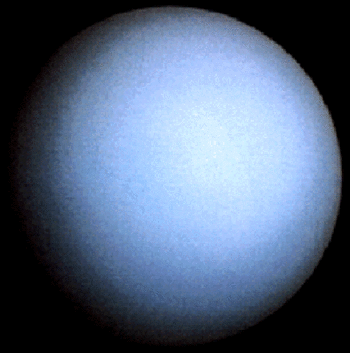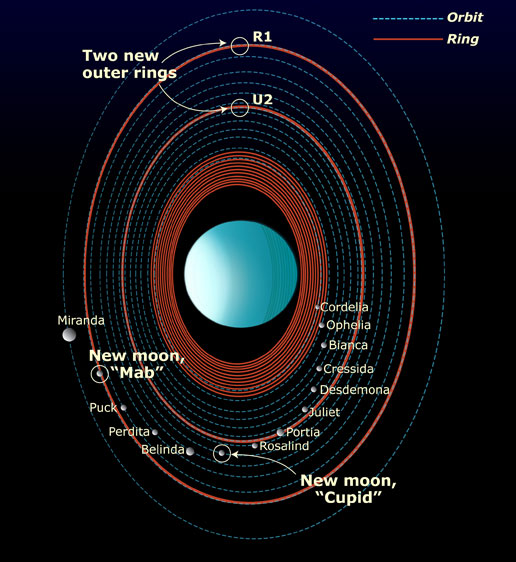Uranus (planet)
Uranus is the seventh planet from the Sun in our solar system. It is a gas giant (also known as a Jovian planet, after the planet Jupiter).
Uranus is so far away from the sun that it takes 84 years on Earth to complete one orbit. In other words, a year on Uranus is equal to 84 years on Earth.[1]
Uranus was discovered using a telescope by astronomer William Herschel in 1781.[1]
Parameters for classification as a planet
Uranus is classified as a planet by the International Astronomical Union for meeting the following criteria:[2]
- Orbits the sun;
- Has mass sufficient for its gravity to form a nearly round shape;
- Has mass sufficient for gravity to clear a path in its orbit.
Physical characteristics
Uranus's distance from the sun is about nineteen and a half times that of earth [3], has a volume 63.1 times the volume of the Earth [4] a diameter of 1.60592 x 105 km and with a mass fourteen times that of Earth (14 Earth masses or 8.6849 X 1025 kg), is the lightest of the outer planets. It has a smaller surface gravity, about 86% of Earth's.[5][1]
It has a much colder core than the other gas giants and radiates very little heat into space.[6][1]
Uranus has no solid surface. Eighty percent or more of Uranus is an extended liquid core of icy materials composed of water, ammonia and methane and higher density materials beneath.[1]
The atmosphere is composed of mainly of hydrogen and helium and has a temperature of about -216 °C.[7] Its atmosphere has small amounts of methane, water and ammonia. Uranus gets its blue-green colour from a combination of light absorbed by the methane layer and light reflected by clouds beneath the methane. The sunlight passes through the methane, is then reflected by the clouds back through the methane layer where the red light portion of the spectrum is absorbed leaving only the blue-green spectrum to pass through, making the atmosphere appear blue-green.[1]
Rotational characteristics
Uniquely among the planets, Neptune orbits the Sun on its side with the axis of rotation of the planet tilted just over 90 degrees with respect to the poles of the ecliptic (the plane of the planet's revolution about the Sun). Thus the rotational axis lies almost in the plane of revolution about the Sun. Due to conservation of angular momentum, the rotational axis maintains the same orientation in space as the planet revolves about the Sun. Thus, twice per planetary year, the axis is pointing almost directly towards the Sun. At the midpoints in the planet's orbit between those times, the planet is rotating in such a way that the Sun is almost on the planetary equator.
Seasons
Natural satellites
Uranus has twenty-seven satellites, named after characters from Shakespeare or Pope, the largest being Titania, Oberon, Umbriel, Ariel and Miranda. Unlike some moons of the other giant planets and Earth's, none of them are larger than the dwarf planets Eris and Pluto.
- Cordelia
- Ophelia
- Bianca
- Cressida
- Desdemona
- Juliet
- Portia
- Rosalind
- Mab
- Belinda
- Perdita
- Puck
- Cupid
- Miranda
- Francisco
- Ariel
- Umbriel
- Titania
- Oberon
- Caliban
- Stephano
- Trinculo
- Sycorax
- Margaret
- Prospero
- Setebos
- Ferdinand
References
- ↑ 1.0 1.1 1.2 1.3 1.4 1.5 1.6 Solar System Exploration: Uranus NASA
- ↑ Honey, I Shrunk the Solar System NASA. “The International Astronomical Union has decided that, to be called a planet, an object must have three traits. It must orbit the sun, be massive enough that its own gravity pulls it into a nearly round shape, and be dominant enough to clear away objects in its neighborhood.”
- ↑ 19.6 AU or 2,870,972,200 km
- ↑ of 6.833 X 1013 km3
- ↑ 8.43 m/s2 or 27.7 ft/s2. By comparison, an object of 100 pounds on Earth will weigh 86 on Uranus. Kilograms is in fact a measure of mass, not weight. 100 Kilgrams on Earth is still 100 kilograms on Uranus. The metric measure for weight is newtons (N). 100 kilograms on Earth where gravity is just a little less than 10 m2 weighs approximately 1000 N. The same mass on Uranus would be 860 N.
- ↑ Hawksett, David; Longstaff, Alan; Cooper, Keith; Clark, Stuart (2005). 10 Mysteries of the Solar System. Astronomy Now. Retrieved on 2006-01-16.
- ↑ -357 °F; 57 K

